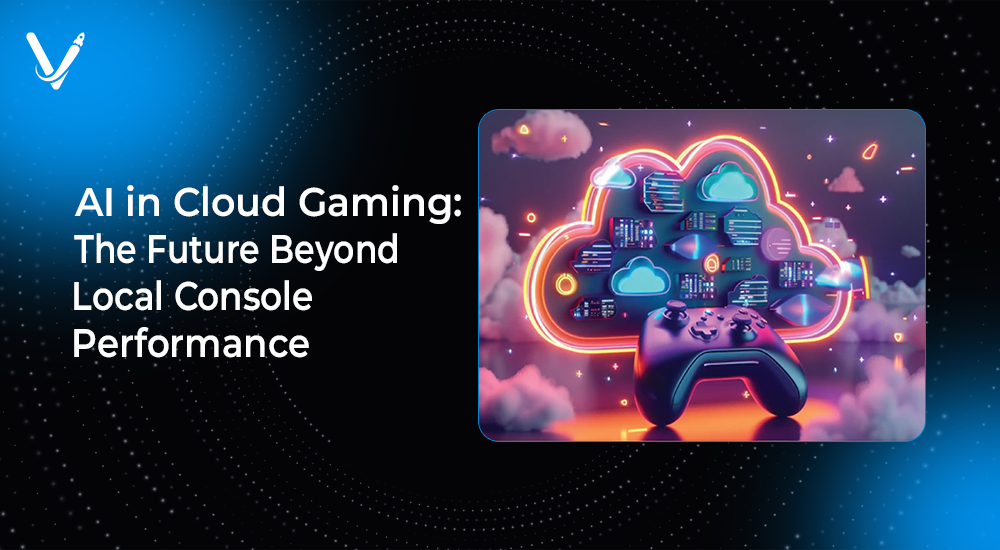AI in Cloud Gaming: The Future Beyond Local Console Performance


- Oct 9, 2025



The gaming industry stands at the crossroads of its most transformative era yet. Gone are the days when performance was limited by the size of a console or the specs of a gaming PC. Today, the cloud has become the new playground, offering gamers the ability to dive into immersive, high-fidelity worlds instantly—without the need for expensive hardware. Yet, the real game-changer in this evolution isn’t just the cloud—it’s artificial intelligence (AI).
AI in cloud gaming is rewriting the rules of how games are played, streamed, optimized, and personalized. It’s the invisible architect ensuring smooth performance, intelligent matchmaking, dynamic scaling, and predictive rendering—all in real time. The combination of AI and cloud technology is not only enhancing player experiences but also redefining the business and technical landscape of game development.
In this article, we’ll explore how AI-driven cloud gaming is reshaping the industry beyond local console limitations. We’ll uncover how AI enhances streaming quality, optimizes server performance, enables personalization, and sets the foundation for the next generation of interactive entertainment.
To appreciate the impact of AI in cloud gaming, it helps to understand what makes cloud gaming different from traditional setups.
In classical gaming, performance depends on the power of local hardware—a console or a PC running the game. The graphics card, CPU, and memory determine how well the game runs. Cloud gaming, however, moves all the heavy computation to remote data centers. The game runs on powerful cloud servers, and the player only receives a video stream of the gameplay on their device.
Instead of downloading and installing gigabytes of data, players can launch a game instantly—just like watching a video on YouTube or Netflix. Cloud gaming eliminates the need for upgrades or hardware limitations, allowing anyone to experience AAA-quality games on any device, be it a low-end laptop or a smartphone.
Cloud gaming democratizes access. It enables seamless gaming across devices and locations. Players no longer need to worry about storage space or console updates. With fast internet connectivity and intelligent cloud infrastructure, even the most graphically intensive games can be played anywhere, anytime.
But as revolutionary as cloud gaming sounds, it faces major challenges—latency, bandwidth management, and rendering efficiency. This is where AI steps in as the ultimate catalyst.
AI is the invisible force powering modern cloud gaming. It doesn’t just enhance graphics or gameplay—it transforms how the entire system functions.
Running massive gaming sessions across global data centers requires efficient allocation of computing resources. AI algorithms predict player demand, optimize workloads, and allocate GPU or CPU resources dynamically to prevent lags or downtime.
By analyzing player activity patterns, AI can anticipate spikes in usage—like new game releases or regional events—and automatically scale infrastructure to meet demand without overloading servers.
This ensures consistent, uninterrupted gameplay even during peak hours—a critical advantage over static, console-based setups.
One of the biggest challenges in cloud gaming is delivering high-quality visuals with low bandwidth. AI-driven rendering techniques like Deep Learning Super Sampling (DLSS) or AI upscaling allow servers to render games at lower resolutions while using machine learning to upscale the visuals in real time.
The result is stunning graphics that look native to 4K or higher—without consuming excessive bandwidth. NVIDIA, Google, and AMD are already leveraging such AI-driven technologies to make cloud rendering faster and more efficient.
AI enables real-time adaptive streaming, adjusting quality dynamically based on internet conditions. If a player’s network fluctuates, AI predicts the optimal bitrate and frame rate to maintain smooth gameplay without interruptions.
This predictive streaming model reduces buffering and input lag—two of the biggest barriers to mainstream cloud gaming adoption.
Latency—the time between a player’s action and the game’s response—is the nemesis of cloud gaming. AI helps predict and reduce latency through edge computing and predictive input models.
Machine learning systems analyze input patterns and network latency to anticipate a player’s next move milliseconds in advance. This proactive approach minimizes perceived lag, creating gameplay that feels instantaneous, even across long distances.
Cloud gaming involves massive amounts of data transfer. AI-based video codecs intelligently compress video streams without quality loss, reducing bandwidth requirements. This ensures that games remain accessible even on moderate internet connections, expanding cloud gaming’s reach globally.
AI doesn’t just optimize performance—it personalizes gaming experiences at an individual level. By analyzing player behavior, preferences, and skill levels, AI tailors gameplay, recommendations, and difficulty dynamically.
AI can monitor player performance in real time and adjust game difficulty accordingly. Instead of static “easy” or “hard” modes, AI-driven systems continuously adapt, ensuring players remain engaged but not frustrated.
In a cloud environment, these adaptive systems can update instantly across millions of users, creating personalized challenges for each gamer.
Much like Netflix recommends movies, AI in cloud gaming suggests titles based on play history, mood, and social trends. These recommendation engines analyze global player data to surface games likely to resonate with users, driving both engagement and revenue for platforms.
AI-powered non-playable characters (NPCs) are evolving into intelligent companions capable of understanding player choices, responding emotionally, and learning behavior patterns. In cloud-based games, these AI entities can evolve dynamically, storing learning data across servers, making them more consistent and realistic.
Imagine an AI companion that remembers your past choices, adapts to your play style, and communicates naturally—a level of immersion once impossible in traditional games.
Behind the scenes, AI is transforming how games are developed, tested, and deployed across cloud platforms.
Testing games manually is time-consuming and error-prone. AI automates the testing process, simulating thousands of gameplay scenarios across different environments. This reduces bugs, optimizes performance, and accelerates release cycles.
Machine learning models can predict potential crash points or performance drops before human testers even identify them, making quality assurance faster and more reliable.
Developers use AI to automatically generate game assets, environments, and levels that adapt dynamically to player behavior. In cloud gaming, this allows endless content creation at scale without requiring massive downloads or updates.
AI-generated content ensures variety and replayability, giving players fresh experiences every time they log in.
Balancing complex multiplayer games across cloud networks is a daunting task. AI analytics evaluate gameplay data, win/loss ratios, and player feedback to fine-tune balance. Developers can push these updates live instantly through the cloud—ensuring fairness and consistency across millions of users.
AI’s integration into the backbone of cloud gaming infrastructure ensures speed, stability, and reliability at a global scale.
Edge computing brings AI processing closer to the player’s device. By running machine learning models at local edge nodes instead of distant data centers, latency drops dramatically.
This decentralization enables real-time rendering, rapid input response, and minimal lag—a key factor in competitive or action-packed games.
AI algorithms manage network traffic intelligently. They analyze global server loads and route player connections to the nearest, most efficient node. This ensures stable frame rates and balanced performance regardless of location.
AI’s predictive models also prevent server bottlenecks by distributing demand proactively during events or peak gaming hours.
AI allows game platforms to automatically scale resources based on usage. During off-peak times, AI reduces resource allocation to save energy and cost. During global launches or eSports events, it instantly expands capacity.
This adaptability ensures efficiency for providers while maintaining uninterrupted performance for players.
AI’s role in cloud gaming goes beyond technology—it reshapes business models, monetization, and market accessibility.
AI-powered optimization reduces dependency on high-end devices, enabling cloud gaming to run efficiently even on low-power systems. This widens accessibility across emerging markets where gaming consoles are unaffordable.
By eliminating hardware barriers, AI-driven cloud platforms open gaming to millions of new users worldwide, accelerating adoption.
AI’s data insights enable dynamic pricing, targeted advertising, and personalized subscription tiers. For instance, AI can analyze player habits to recommend microtransactions, seasonal passes, or exclusive content that align with user interests.
Predictive models help companies optimize marketing spend, increasing ROI while improving player satisfaction.
Cloud-native AI tools streamline development workflows, allowing studios to focus on creativity rather than infrastructure. With scalable AI services, developers can test, deploy, and update games globally in real time.
This reduces operational costs while maintaining consistency across devices—a win-win for both creators and gamers.
The future of cloud gaming isn’t just about streaming; it’s about living, evolving virtual worlds enhanced by artificial intelligence.
AI models simulate realistic environments by predicting particle movement, lighting, and physics behavior dynamically. This enables hyperrealistic visuals and lifelike interactions, previously limited by local GPU power.
AI-driven voice and emotion recognition allow games to respond to player emotions in real time. Imagine a horror game that adapts its intensity based on your fear level, detected through voice tone or biometric input.
Cloud-based AI models process this data seamlessly, delivering emotionally intelligent gameplay experiences.
AI ensures consistent performance and synchronization across multiple platforms—mobile, PC, smart TVs, or VR headsets. No matter the device, gameplay feels unified, fluid, and immersive.
Cloud computing allows AI to maintain persistent virtual worlds that evolve even when players are offline. These living ecosystems track global events, weather systems, and AI populations—creating universes that feel truly alive.
Despite its promise, AI-driven cloud gaming faces challenges that require thoughtful resolution.
Balancing innovation with ethics will be key to building a responsible future for cloud gaming.
The convergence of AI and cloud computing signals a new dawn for the gaming industry—a shift from static, device-bound experiences to intelligent, limitless ecosystems.
We’re entering an age where games evolve with players, environments respond dynamically, and experiences transcend hardware constraints.
Soon, AI will manage entire cloud-based gaming universes autonomously—balancing resources, adapting narratives, and personalizing worlds for every individual. Combined with emerging technologies like 5G, edge computing, and quantum AI, the possibilities become infinite.
For developers, publishers, and players alike, AI in cloud gaming isn’t just the future—it’s the foundation of a new digital frontier.
The fusion of AI and cloud gaming represents a monumental leap forward for the gaming industry. Together, they dissolve the limitations of local consoles, ushering in an era where performance, accessibility, and personalization reach new heights.
AI optimizes every layer of cloud gaming—from rendering and latency control to storytelling and player engagement. By combining real-time intelligence with distributed infrastructure, developers can deliver cinematic-quality experiences to anyone, anywhere, on any device.
At Vasundhara Infotech, we believe the future of gaming lies in this synergy. Our expertise in AI-powered cloud gaming development helps studios, startups, and enterprises create scalable, immersive experiences that stand out in a rapidly evolving digital ecosystem.
If you’re ready to build the next generation of cloud-based gaming solutions, Vasundhara Infotech can turn your vision into a cutting-edge reality.
Copyright © 2025 Vasundhara Infotech. All Rights Reserved.